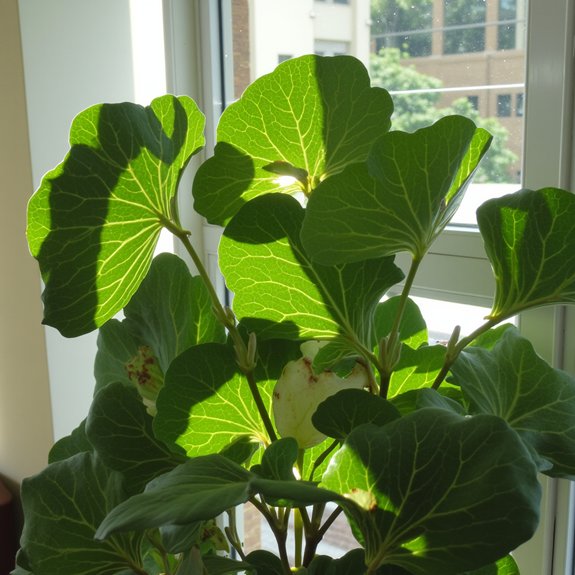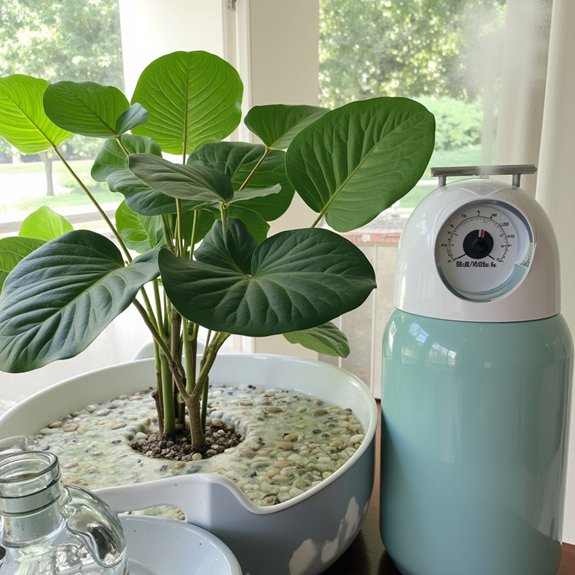Fiddle leaf fig owners often discover their beloved plants sending distress signals through mysteriously curled leaves, yet most people misdiagnose the underlying cause entirely. The curling patterns actually reveal specific environmental problems, from subtle light changes to hidden pest invasions that remain invisible to the naked eye. Each curl direction tells a different story about what’s happening beneath the surface. Understanding these botanical clues means the difference between a thriving plant and watching expensive foliage slowly deteriorate week after week.
Contents
- 1 Light Conditions That Trigger Leaf Curling
- 2 Watering Issues and Their Impact on Leaves
- 3 Humidity Requirements for Healthy Foliage
- 4 Pest Infestations Causing Leaf Deformation
- 5 Fertilizer Problems and Nutrient Imbalances
- 6 Water Quality and Soil Health Concerns
- 7 Temperature Stress and Environmental Changes
- 8 Disease Prevention and Recovery Strategies
Light Conditions That Trigger Leaf Curling

When fiddle leaf figs receive too much direct sunlight, their leaves instinctively curl inward to protect themselves from potential damage. This natural defense mechanism helps conserve moisture while shielding delicate leaf tissue from intense rays that can cause permanent burning.
Light intensity plays an essential role in leaf health. Bright, indirect light keeps leaves flat and healthy, while harsh direct sunlight triggers defensive curling. Gradually relocating plants away from windows or using sheer curtains reduces harmful exposure.
Light adaptation takes time, typically 2-3 weeks. Moving plants slowly allows proper adjustment without shocking the system.
Watering Issues and Their Impact on Leaves
Beyond light exposure, improper watering ranks as the most common culprit behind curling fiddle leaf fig leaves. Both underwatering and overwatering trigger this defensive response, though with different patterns.
Underwatered plants curl leaves upward to reduce surface area, conserving precious moisture. Check soil moisture by lifting the pot—light weight indicates dry soil. Adjust watering frequency based on seasonal changes and humidity levels.
Overwatering creates downward-curling leaves, often accompanied by yellowing. Poor moisture retention in soggy soil suffocates roots, preventing proper nutrient uptake. Wait until the top half of soil dries before watering again, avoiding rigid schedules that ignore environmental fluctuations.
Humidity Requirements for Healthy Foliage

Although watering gets most attention, humidity levels play an equally essential role in preventing leaf curl in fiddle leaf figs. These tropical natives require 40-60% humidity to thrive, with consistency being critical. Low humidity causes leaves to curl inward and develop brown edges as the plant conserves moisture.
Humidity monitors help track levels accurately throughout your home. When readings drop below 40%, consider multiple humidity sources like humidifiers, pebble trays, or grouping plants together. Room humidifiers provide the most reliable solution, especially during winter months when indoor air becomes particularly dry and problematic.
Pest Infestations Causing Leaf Deformation
While watering and humidity issues often take center stage, pest infestations can quietly wreak havoc on fiddle leaf fig foliage, causing distinctive curling and deformation patterns. Spider mites create fine webbing while sucking plant juices, leading to curled, stippled leaves. Mealybugs appear as white, cotton-like clusters, causing leaves to curl inward defensively.
Proper pest identification requires close inspection of leaf undersides and stem joints. Spider mites leave tiny yellow dots, while mealybugs produce sticky honeydew residue.
Effective pest treatment involves isolating the plant immediately, then applying insecticidal soap or neem oil weekly until eliminated, typically requiring 2-3 applications for complete eradication.
Fertilizer Problems and Nutrient Imbalances

After eliminating pest problems, gardeners often discover that improper fertilization creates its own set of leaf-curling challenges. Overfertilizing causes salt buildup in soil, leading to nutrient burn and curled leaves. Monthly fertilizer frequency during growing season prevents this issue, while excessive feeding requires flushing soil with water.
Nutrient deficiencies create opposite problems but similar symptoms. Lack of nitrogen, potassium, or magnesium causes leaves to curl inward as the plant struggles. Balanced liquid fertilizer diluted to half-strength works best for fiddle leaf figs. Stop fertilizing completely during winter months when growth slows, resuming gradual feeding in spring.
Water Quality and Soil Health Concerns
Beyond fertilizer missteps, poor water quality and compromised soil create equally troubling leaf-curling problems that many plant owners overlook. Tap water contains chlorine and fluoride that accumulate in soil, causing chemical buildup that stresses roots. Filtered or rainwater prevents these harmful deposits from forming. Meanwhile, soil health deteriorates when drainage fails, creating waterlogged conditions that suffocate roots. Compacted soil blocks oxygen flow, mimicking overwatering symptoms. Check containers for adequate drainage holes, and ascertain potting mix remains loose and airy. Quality water paired with well-draining soil creates the foundation for healthy, uncurled leaves.
Temperature Stress and Environmental Changes
Temperature fluctuations create immediate stress responses in Fiddle Leaf Figs, causing leaves to curl defensively within hours of environmental shifts. These tropical plants prefer consistent temperatures between 65-75°F, becoming stressed when exposed to sudden drops below 60°F or spikes above 85°F. Environmental consistency proves essential for preventing leaf curl, as even minor temperature changes of 10-15 degrees can trigger defensive responses. Drafty windows, heating vents, and air conditioning units commonly cause these fluctuations. Moving plants away from temperature sources and monitoring conditions with a thermometer helps maintain the stable environment these sensitive plants require for ideal health.
Disease Prevention and Recovery Strategies
Several key strategies dramatically reduce disease risk in Fiddle Leaf Figs while promoting faster recovery when problems arise. Effective disease identification strategies include weekly leaf inspections, checking for brown spots, yellowing patterns, and unusual curling. Remove affected foliage immediately using sterilized pruning shears to prevent spread. Maintain proper airflow around plants, avoiding water on leaves during care routines. Recovery techniques focus on environmental stability, ensuring consistent temperatures between 65-75°F and humidity levels around 60%. Well-draining soil prevents root issues, while filtered water eliminates chemical buildup. Monitor plants closely during recovery, adjusting care based on new growth patterns and overall plant response.
